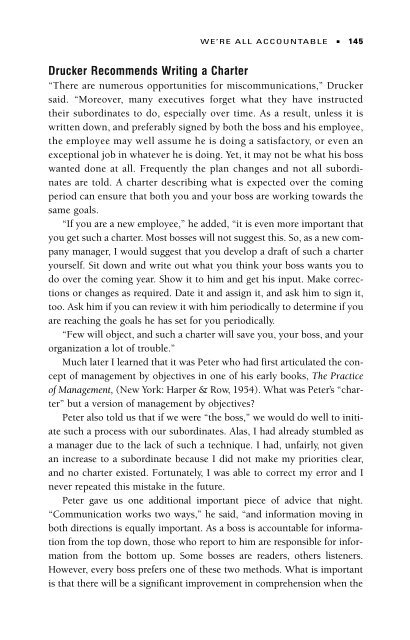A Class with Drucker - Headway | Work on yourself
A Class with Drucker - Headway | Work on yourself
A Class with Drucker - Headway | Work on yourself
You also want an ePaper? Increase the reach of your titles
YUMPU automatically turns print PDFs into web optimized ePapers that Google loves.
WE’RE ALL ACCOUNTABLE ■ 145<br />
<str<strong>on</strong>g>Drucker</str<strong>on</strong>g> Recommends Writing a Charter<br />
“There are numerous opportunities for miscommunicati<strong>on</strong>s,” <str<strong>on</strong>g>Drucker</str<strong>on</strong>g><br />
said. “Moreover, many executives forget what they have instructed<br />
their subordinates to do, especially over time. As a result, unless it is<br />
written down, and preferably signed by both the boss and his employee,<br />
the employee may well assume he is doing a satisfactory, or even an<br />
excepti<strong>on</strong>al job in whatever he is doing. Yet, it may not be what his boss<br />
wanted d<strong>on</strong>e at all. Frequently the plan changes and not all subordinates<br />
are told. A charter describing what is expected over the coming<br />
period can ensure that both you and your boss are working towards the<br />
same goals.<br />
“If you are a new employee,” he added, “it is even more important that<br />
you get such a charter. Most bosses will not suggest this. So, as a new company<br />
manager, I would suggest that you develop a draft of such a charter<br />
<strong>yourself</strong>. Sit down and write out what you think your boss wants you to<br />
do over the coming year. Show it to him and get his input. Make correcti<strong>on</strong>s<br />
or changes as required. Date it and assign it, and ask him to sign it,<br />
too. Ask him if you can review it <str<strong>on</strong>g>with</str<strong>on</strong>g> him periodically to determine if you<br />
are reaching the goals he has set for you periodically.<br />
“Few will object, and such a charter will save you, your boss, and your<br />
organizati<strong>on</strong> a lot of trouble.”<br />
Much later I learned that it was Peter who had first articulated the c<strong>on</strong>cept<br />
of management by objectives in <strong>on</strong>e of his early books, The Practice<br />
of Management, (New York: Harper & Row, 1954). What was Peter’s “charter”<br />
but a versi<strong>on</strong> of management by objectives?<br />
Peter also told us that if we were “the boss,” we would do well to initiate<br />
such a process <str<strong>on</strong>g>with</str<strong>on</strong>g> our subordinates. Alas, I had already stumbled as<br />
a manager due to the lack of such a technique. I had, unfairly, not given<br />
an increase to a subordinate because I did not make my priorities clear,<br />
and no charter existed. Fortunately, I was able to correct my error and I<br />
never repeated this mistake in the future.<br />
Peter gave us <strong>on</strong>e additi<strong>on</strong>al important piece of advice that night.<br />
“Communicati<strong>on</strong> works two ways,” he said, “and informati<strong>on</strong> moving in<br />
both directi<strong>on</strong>s is equally important. As a boss is accountable for informati<strong>on</strong><br />
from the top down, those who report to him are resp<strong>on</strong>sible for informati<strong>on</strong><br />
from the bottom up. Some bosses are readers, others listeners.<br />
However, every boss prefers <strong>on</strong>e of these two methods. What is important<br />
is that there will be a significant improvement in comprehensi<strong>on</strong> when the


